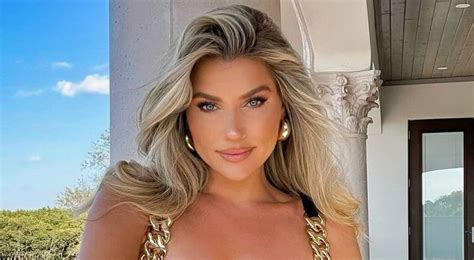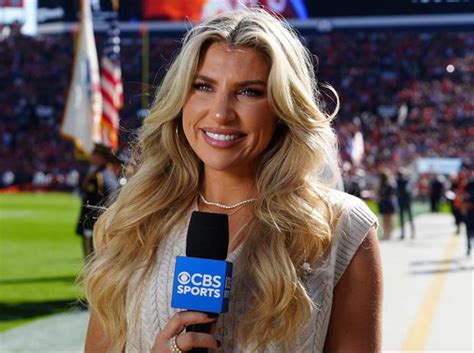
Melanie Collins, CBS Sports sideline reporter, ignited a social media frenzy with her fashion choice during a recent NFL broadcast, drawing significant attention and praise for her on-air style.
Collins’ sleek, body-conscious dress became a major talking point among viewers, with many taking to social media platforms like X (formerly Twitter) to express their admiration and inquire about the outfit’s details. The particular dress, a neutral-toned midi, was noted for its flattering fit and sophisticated design, perfectly complementing Collins’ professional demeanor and on-screen presence.
The buzz surrounding Collins’ outfit underscores the increasing interest in sideline reporters’ fashion choices, highlighting how their style can become an integral part of the broadcast experience. This incident reflects a broader trend where viewers are increasingly engaged not only with the sports coverage itself but also with the personalities and appearances of those delivering the news and commentary.
“Another week, another slay for @Melanie_Collins,” one fan wrote on X, encapsulating the general sentiment of online users. Others were quick to identify the dress, sharing links and details for those hoping to emulate Collins’ look.
The attention garnered by Collins’ dress highlights the visual aspect of modern sports broadcasting, where sideline reporters are not only expected to provide insightful commentary but also to maintain a polished and engaging appearance. It further exemplifies how fashion choices can contribute to a reporter’s overall brand and appeal, drawing in viewers and enhancing the broadcast’s overall appeal.
Expanded Context and Analysis:
The phenomenon of sideline reporters’ fashion choices garnering attention is not entirely new. Over the years, several female sports reporters have found themselves in the spotlight for their on-air style, demonstrating how fashion has become an unexpected but significant element of sports broadcasting. This trend reflects a broader cultural shift where visual media plays an increasingly important role in shaping perceptions and influencing trends.
In an era where social media amplifies every aspect of public life, sideline reporters’ outfits are often scrutinized and discussed, contributing to their public image and brand. While the primary focus remains on their journalistic contributions, their appearance can impact how they are perceived by viewers and the industry at large.
The focus on Melanie Collins’ dress also brings to light the subtle pressures female sports reporters face. While male reporters’ attire is often overlooked, female reporters are frequently subject to commentary on their clothing, hair, and makeup. Navigating this landscape requires a delicate balance of professionalism, style, and personal expression.
The positive reaction to Collins’ dress suggests a growing appreciation for sideline reporters who embrace fashion as a form of self-expression while maintaining their professional integrity. By showcasing her personal style, Collins has not only captured the attention of viewers but also contributed to the evolving image of female sports reporters in the media landscape.
Moreover, the social media buzz surrounding Collins’ dress exemplifies the power of fashion to create a connection between reporters and viewers. By sharing details about her outfits, Collins engages with her audience on a personal level, fostering a sense of community and shared interest.
The Role of Social Media:
Social media platforms such as X (formerly Twitter), Instagram, and Facebook have played a crucial role in amplifying the attention given to sideline reporters’ fashion choices. These platforms provide a space for viewers to share their opinions, ask questions, and connect with reporters on a more personal level.
In the case of Melanie Collins, the social media buzz surrounding her dress served as a form of viral marketing, drawing even more attention to her on-air appearance and increasing her visibility within the sports broadcasting community.
Furthermore, social media allows viewers to dissect and analyze every aspect of a reporter’s outfit, from the brand and style to the color and fit. This level of scrutiny can be both positive and negative, providing reporters with valuable feedback while also subjecting them to potential criticism and judgment.
The prevalence of social media also underscores the importance of reporters maintaining a strong online presence. By actively engaging with their followers and sharing insights into their personal style, reporters can cultivate a loyal fan base and enhance their overall brand.
Fashion as a Form of Self-Expression:
For many sideline reporters, fashion is more than just a superficial concern; it is a form of self-expression that allows them to showcase their personality and style while maintaining a professional demeanor. By choosing outfits that reflect their individual taste and preferences, reporters can communicate their confidence and professionalism to viewers.
Melanie Collins’ dress serves as a prime example of how fashion can be used to make a statement without being overtly flashy or distracting. The dress’s sleek design and neutral tone conveyed a sense of sophistication and elegance, while its flattering fit accentuated Collins’ figure without being overly revealing.
Furthermore, fashion can be a powerful tool for breaking down stereotypes and challenging traditional notions of what a sports reporter should look like. By embracing their personal style, reporters can demonstrate that fashion and athleticism are not mutually exclusive.
The Evolution of Sideline Reporting:
The role of sideline reporters has evolved significantly over the years, from simply providing updates on injuries and substitutions to offering in-depth analysis and commentary on the game. As the role has evolved, so too has the appearance of sideline reporters.
In the early days of sports broadcasting, sideline reporters were often relegated to the sidelines, providing brief updates with little opportunity for personality or style. However, as the industry has become more competitive and visually oriented, sideline reporters have been given more freedom to express themselves through their appearance.
This evolution reflects a broader trend in media, where personality and style are increasingly valued alongside traditional journalistic skills. Today, sideline reporters are expected to be not only knowledgeable and articulate but also engaging and visually appealing.
Challenges and Considerations:
While the attention given to sideline reporters’ fashion choices can be positive, it also presents certain challenges and considerations. One of the primary challenges is the potential for objectification, where reporters are judged solely on their appearance rather than their journalistic skills.
To combat this, it is essential for reporters to prioritize their professional integrity and focus on delivering insightful and informative commentary. By demonstrating their expertise and knowledge, reporters can shift the focus away from their appearance and toward their contributions to the broadcast.
Another challenge is the pressure to conform to certain beauty standards, which can be particularly acute for female reporters. To navigate this pressure, it is essential for reporters to embrace their individuality and choose outfits that make them feel confident and comfortable.
The Impact on Viewership:
The attention given to sideline reporters’ fashion choices can have a significant impact on viewership, particularly among female viewers. By showcasing stylish and confident reporters, sports broadcasts can attract a broader audience and create a more engaging viewing experience.
Furthermore, the social media buzz surrounding reporters’ outfits can generate additional interest in the broadcast, driving up viewership and increasing overall engagement.
However, it is important to note that the focus on fashion should not overshadow the primary goal of providing informative and insightful sports coverage. The most successful sideline reporters are those who strike a balance between style and substance, delivering both engaging commentary and a polished appearance.
The Future of Sideline Style:
As the media landscape continues to evolve, the role of fashion in sports broadcasting is likely to become even more prominent. In the future, we can expect to see more sideline reporters embracing their personal style and using fashion as a tool for self-expression.
Furthermore, we can anticipate the emergence of new technologies and platforms that allow viewers to engage with reporters’ fashion choices in real-time, such as interactive styling apps and social media polls.
Ultimately, the future of sideline style will depend on the ability of reporters to navigate the challenges and opportunities presented by the evolving media landscape, striking a balance between professionalism, style, and personal expression.
The Broader Implications for Women in Sports Media:
The focus on Melanie Collins’ dress also speaks to the broader challenges and opportunities for women in sports media. While progress has been made in terms of representation and recognition, women in sports media still face significant hurdles, including gender bias, online harassment, and unequal pay.
The attention given to Collins’ dress can be seen as both a positive and a negative development. On the one hand, it highlights the visibility and influence of women in sports media. On the other hand, it underscores the tendency to focus on women’s appearance rather than their professional accomplishments.
To ensure that women in sports media are recognized for their talent and expertise, it is essential to challenge gender stereotypes and promote a more inclusive and equitable media landscape. This includes providing women with equal opportunities for advancement, addressing online harassment, and celebrating their contributions to the field.
Conclusion:
Melanie Collins’ dress has sparked a wider conversation about the role of fashion in sports broadcasting. While the focus on appearance can be both positive and negative, it underscores the increasing importance of visual media in shaping perceptions and influencing trends.
By embracing their personal style and maintaining their professional integrity, sideline reporters can use fashion as a tool for self-expression and for connecting with viewers on a more personal level. Ultimately, the most successful reporters are those who strike a balance between style and substance, delivering both engaging commentary and a polished appearance.
The attention given to Collins’ dress serves as a reminder of the evolving media landscape and the challenges and opportunities facing women in sports media. By promoting a more inclusive and equitable media landscape, we can ensure that women are recognized for their talent and expertise, rather than solely for their appearance.
Frequently Asked Questions (FAQ):
1. What dress did Melanie Collins wear that caused the social media buzz?
The dress that sparked the online buzz was a neutral-toned midi dress. Details about the specific brand or designer were not explicitly mentioned in the source article but were reportedly identified and shared by fans on social media platforms.
2. Why is there so much attention on what sideline reporters wear?
Sideline reporters, particularly women, are in the public eye, and their appearance becomes part of the broadcast experience. Social media amplifies this, with viewers sharing opinions and inquiring about their outfits. It reflects a broader trend where visual media influences perceptions.
3. How do sideline reporters balance professionalism and personal style?
Balancing professionalism and personal style requires carefully selecting outfits that are both stylish and appropriate for the broadcast. Many reporters choose outfits that reflect their personality while maintaining a polished and sophisticated appearance, ensuring their fashion choices enhance rather than distract from their reporting.
4. Is the focus on fashion for sideline reporters a positive or negative trend?
It can be both. Positively, it can increase visibility and connect reporters with viewers. Negatively, it can lead to objectification if reporters are judged solely on appearance rather than journalistic skills. The key is to maintain professional integrity and focus on delivering insightful commentary.
5. How has social media impacted the attention given to sideline reporters’ fashion?
Social media platforms amplify attention on reporters’ fashion by allowing viewers to share opinions, ask questions, and connect with reporters. This can lead to viral marketing, but also subjects reporters to scrutiny and potential criticism. It highlights the importance of reporters maintaining a strong online presence.
In-Depth Look at the Visual Impact of Sideline Reporting:
Sideline reporting, initially conceived as a supplementary element to the main sports broadcast, has evolved into a visually dynamic and narratively rich component that significantly enhances the viewer experience. The role of the sideline reporter extends beyond merely relaying information; it encompasses creating a connection with the audience through a blend of journalistic integrity, on-screen presence, and personal style.
The visual impact of sideline reporters, particularly in the realm of fashion, is a multifaceted phenomenon that encapsulates several layers of influence. First and foremost, the attire of a sideline reporter contributes to the overall aesthetic appeal of the broadcast. In an era dominated by high-definition television and visually oriented social media platforms, the visual quality of a broadcast is paramount. A well-dressed sideline reporter, like Melanie Collins, adds a touch of sophistication and glamour to the proceedings, enhancing the overall viewing experience.
Furthermore, fashion serves as a non-verbal form of communication, conveying messages of professionalism, confidence, and approachability. The choices a sideline reporter makes in terms of clothing, accessories, and grooming can signal their level of preparedness, attention to detail, and respect for the audience. In this context, Melanie Collins’ dress selection becomes a deliberate statement, projecting an image of poise and competence that aligns with the demands of her role.
Moreover, the visual appeal of sideline reporters can foster a sense of connection with the audience, particularly among female viewers. By showcasing stylish and contemporary fashion choices, reporters like Collins can resonate with viewers who appreciate the integration of style and sports. This can lead to increased engagement and viewership, as viewers feel a stronger connection to the broadcast and the personalities involved.
However, the visual focus on sideline reporters is not without its challenges and complexities. One of the primary concerns is the potential for objectification, where the reporter’s appearance overshadows their journalistic contributions. In order to mitigate this risk, it is essential for reporters to prioritize their professional integrity and expertise, ensuring that their commentary and analysis are the primary focus of their work.
Additionally, the visual emphasis can perpetuate unrealistic beauty standards, placing undue pressure on female reporters to conform to societal expectations. To counteract this, it is imperative for reporters to embrace their individuality and promote body positivity, challenging traditional notions of beauty and promoting a more inclusive and accepting media landscape.
The Intersection of Fashion and Journalism:
The intersection of fashion and journalism, particularly in the context of sports broadcasting, is a nuanced and multifaceted phenomenon that reflects broader cultural trends and societal values. While journalism traditionally emphasizes objectivity, accuracy, and impartiality, fashion introduces elements of subjectivity, personal expression, and visual appeal.
In the realm of sideline reporting, the integration of fashion into the journalistic landscape can be both empowering and challenging. On the one hand, fashion allows reporters to express their individuality, showcase their personal style, and connect with the audience on a more personal level. On the other hand, it can also lead to objectification, superficiality, and undue scrutiny.
To navigate this complex terrain, it is essential for sideline reporters to strike a delicate balance between style and substance, ensuring that their fashion choices enhance, rather than detract from, their journalistic contributions. This requires a thoughtful and deliberate approach to fashion, prioritizing professionalism, appropriateness, and authenticity.
Furthermore, it is imperative for media organizations to support and empower sideline reporters, providing them with the resources and guidance they need to make informed fashion choices that align with their personal brand and professional goals. This includes offering access to stylists, designers, and fashion experts, as well as fostering a culture of respect and inclusivity that values individuality and diversity.
A Look at the History and Evolution of Sideline Reporting:
The history and evolution of sideline reporting offer valuable insights into the changing dynamics of sports broadcasting and the evolving role of the sideline reporter. Initially conceived as a mere addendum to the main broadcast, sideline reporting has evolved into a critical component that provides viewers with real-time updates, behind-the-scenes insights, and player interviews.
In the early days of sports broadcasting, sideline reporters were primarily responsible for relaying information about injuries, substitutions, and weather conditions. Their role was largely informational, with little emphasis on personality or style. However, as the industry grew more competitive and visually oriented, the role of the sideline reporter expanded to include elements of storytelling, analysis, and personal connection.
This evolution has been accompanied by a gradual shift in the demographics of sideline reporters, with more women and people of color entering the field. This increased diversity has brought new perspectives and voices to the broadcast, enriching the viewing experience and challenging traditional stereotypes.
Furthermore, the rise of social media has transformed the role of the sideline reporter, providing them with new platforms for engaging with viewers, sharing insights, and building their personal brand. This has led to a more interactive and dynamic relationship between reporters and their audience, fostering a sense of community and shared passion.
The Ethics of Fashion in Sports Journalism:
The ethics of fashion in sports journalism is a complex and multifaceted issue that raises questions about objectivity, impartiality, and professional integrity. While fashion can be a form of self-expression and a means of connecting with the audience, it can also create conflicts of interest, compromise credibility, and perpetuate harmful stereotypes.
To navigate these ethical dilemmas, it is essential for sports journalists to adhere to a strict code of conduct that prioritizes objectivity, accuracy, and fairness. This includes avoiding endorsements, sponsorships, and other financial arrangements that could compromise their impartiality.
Furthermore, it is imperative for sports journalists to be mindful of the messages their fashion choices convey, avoiding attire that could be seen as offensive, disrespectful, or inappropriate. This requires a thoughtful and deliberate approach to fashion, considering the context, audience, and purpose of their work.
In addition, it is essential for media organizations to provide clear guidelines and training on ethical fashion choices, ensuring that sports journalists are equipped to make informed decisions that align with the values and principles of their profession.
By upholding the highest ethical standards, sports journalists can maintain their credibility, integrity, and public trust, ensuring that their fashion choices enhance, rather than detract from, their journalistic contributions.
Long-Term Impact and Implications:
The attention garnered by Melanie Collins’ dress extends beyond a momentary social media frenzy. It underscores a broader shift in media consumption, where visual appeal and personal connection play increasingly significant roles. This has long-term implications for the sports broadcasting industry, particularly for female sideline reporters.
The heightened focus on fashion can create both opportunities and challenges. On one hand, it provides reporters with a platform to express their individuality, connect with viewers on a personal level, and build their brand. On the other hand, it can perpetuate objectification, create unrealistic beauty standards, and distract from their journalistic work.
To navigate these complexities, it is crucial for media organizations to foster a culture that values both substance and style, recognizing that fashion can be a powerful tool for communication and engagement, but should never overshadow the core principles of journalism.
Furthermore, it is essential for female sideline reporters to support and empower one another, challenging stereotypes, advocating for fair treatment, and celebrating their achievements. By working together, they can create a more inclusive and equitable media landscape where their talent, expertise, and contributions are recognized and valued.









